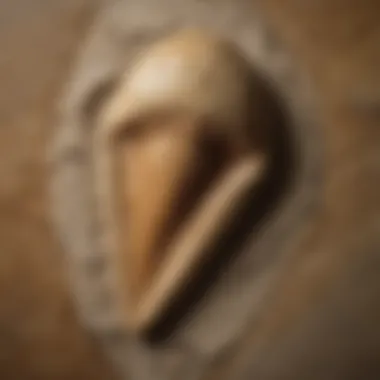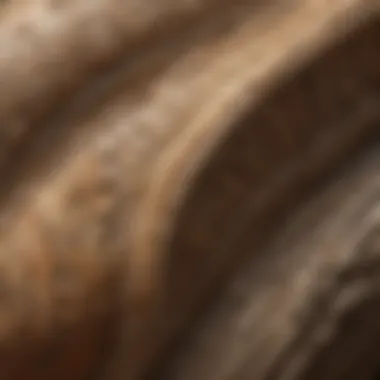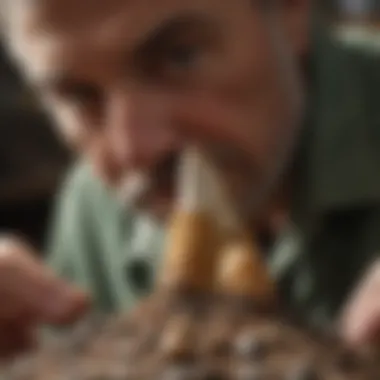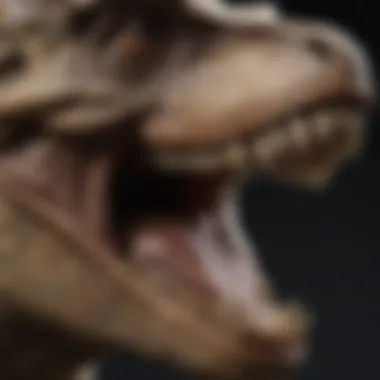Exploring the Enigmatic Tale of a Fossilised Dinosaur Tooth


Rock and Fossil Identification
In the fascinating realm of paleontology, understanding the types of rocks and fossils is paramount to unraveling the mysteries of a fossilized dinosaur tooth. Rocks come in various forms such as sedimentary, igneous, and metamorphic, each with distinctive features that aid in identification. Fossils, on the other hand, range from impressions and molds to casts and petrified remains. The key characteristics to look for when identifying fossils include texture, color, shape, and any imprints or markings that indicate its origin.
To delve deeper into rock and fossil identification, tools play a crucial role in assisting collectors and researchers. Tools such as picks, brushes, chisels, and magnifying glasses are essential for intricate excavations and examinations. These tools not only facilitate the extraction of fossils but also aid in analyzing their structure and composition, providing valuable insights into prehistoric life forms.
Collecting Tips and Techniques
Embarking on a journey to uncover the enigmatic remnants of prehistoric creatures requires precise collecting tips and techniques. Best practices for collecting fossils involve thorough research on prime collecting sites, where geological conditions are conducive to preserving ancient relics. By honing in on areas with sedimentary rock formations and exposed fossil deposits, collectors increase their chances of discovering well-preserved specimens.
Locating prime collecting sites involves careful observation of geological structures and sediment layers, as fossils are often preserved in specific rock formations. Utilizing geological maps and collaborating with seasoned collectors can streamline the process of identifying optimal collecting locations, ensuring a fruitful and educational experience.
Safely extracting specimens from their rocky encasements is vital to preserving fossils for scientific study. Techniques such as jacketing, plaster casting, and meticulous chiseling help prevent damage to fragile fossils during excavation. By employing meticulous attention to detail and following established protocols, collectors can ethically procure fossils while maintaining their integrity.
Preservation and Display
Once a fossilized dinosaur tooth is unearthed, the significance of preserving it for future generations cannot be overstated. Techniques for preserving fossils include stabilizing fragile specimens with consolidants, removing excess sediment, and storing them in controlled environments to prevent deterioration. Proper storage methods, such as archival-grade containers and climate-controlled settings, safeguard fossils from environmental fluctuations and degradation.
Creative display ideas offer enthusiasts the opportunity to showcase their fossil collections in engaging and visually appealing ways. Designing custom mounts, shadow boxes, and interactive exhibits not only enhance the aesthetic appeal of fossils but also educate viewers on the scientific importance of these ancient artifacts.
Geological Insights
Exploring the geological context of fossilized dinosaur teeth unveils a wealth of insights into Earth's dynamic history. Geological formations and processes, such as sedimentation, tectonic activity, and mineral deposition, influence the preservation and distribution of fossils. Understanding the historical significance of rocks and fossils enhances our appreciation for the Earth's evolution over millions of years.
Notable discoveries in the field of paleontology have reshaped our understanding of prehistoric life forms and ecosystems. From the unearthing of complete dinosaur skeletons to the identification of new species, these discoveries contribute to our growing knowledge of ancient life on Earth. By delving into geological insights, we gain a deeper appreciation for the intricate relationships between Earth's geology and its fossil record.
Introduction
In the realm of paleontology lies a captivating enigma waiting to be unraveled - the mystery encapsulated within a fossilised dinosaur tooth. This revered artifact holds within its mineralized structures tales of ancient ecosystems, evolutionary pathways, and long-extinct species. As we embark on this scientific journey, we are transported back millions of years to a time when dinosaurs roamed the Earth, offering us a glimpse into a world long past but forever preserved in the fossil record.
The significance of studying a fossilised dinosaur tooth transcends mere curiosity; it opens a window to the past that allows us to piece together the intricate puzzle of prehistoric life. By examining the composition, morphology, and isotopic signatures of these teeth, paleontologists can reconstruct ancient landscapes, infer dietary preferences of extinct creatures, and even track biogeographic movements of different species over millennia.
One cannot understate the importance of the Introduction section in this article, as it serves as the gateway to a fascinating exploration of paleontological wonders. Here, we lay the foundation for unraveling the mysteries held within a seemingly ordinary yet extraordinary relic of the past. By delving into the formation process, discovery circumstances, and scientific significance of a fossilised dinosaur tooth, we set the stage for a comprehensive elucidation of the secrets that lie dormant within this ancient artifact.
The Origins of the Fossilised Dinosaur Tooth
In the intriguing exploration of unveiling the mysteries of a fossilized dinosaur tooth, delving into the origins holds paramount importance. Understanding the formation process of such a relic provides invaluable insights into the ancient world it belongs to. The significance of unraveling the specifics around mineral replacement, preservation conditions, and geological context lies in deciphering the history and environmental influences that shaped these ancient remains. By focusing on these specific elements, we are not only piecing together the story of the fossilized dinosaur tooth but also shedding light on the broader scope of prehistoric times.


Formation Process
Mineral Replacement
Digging deeper into the formation process of a fossilized dinosaur tooth involves a meticulous examination of mineral replacement. This process, wherein organic materials are gradually replaced by minerals, plays a pivotal role in the preservation and fossilization of ancient remains. The key characteristic of mineral replacement lies in its ability to retain the structure of the original organic material while transforming it into a durable mineralized form. This unique feature ensures that the fossil remains intact over millennia, providing researchers with a wealth of information about ancient life forms. Despite its advantages in facilitating the long-term preservation of fossils, mineral replacement may also present challenges in accurately preserving finer details of the original organic material.
Preservation Conditions
Another critical aspect of the formation process is understanding the preservation conditions under which fossilization occurs. The preservation conditions dictate the quality and completeness of the fossilized remains, making it essential to analyze the environmental factors that contribute to this process. By highlighting the specific conditions that favor fossilization, such as sedimentation rates and mineral content in the surrounding soil, researchers can gain a comprehensive understanding of how these ancient relics have endured through time. While these conditions are beneficial in safeguarding fossils from deterioration, they also pose risks in terms of altering the original composition of the remains, underscoring the delicate balance in achieving optimal preservation outcomes.
Geological Context
Exploring the geological context surrounding the fossilized dinosaur tooth is critical in unraveling its origins and significance. The stratigraphic layers in which the tooth is found offer clues about the ancient environments and ecosystems that existed during the dinosaur's reign. By analyzing the geological context, researchers can reconstruct the landscape, climate, and biodiversity of that era, providing a deeper understanding of the evolutionary history of these captivating creatures. While the geological context enhances our knowledge of the past, it also introduces complexities related to the interpretation of fossil data, requiring meticulous attention to detail when piecing together the puzzle of prehistoric life.
Scientific Analysis
In the elaborate realm of paleontology, the Scientific Analysis section serves as a pivotal component, offering a profound insight into the intricate details of the fossilised dinosaur tooth. This segment delves deep into the methodologies, techniques, and findings that bridge the past with the present. Through meticulous examination and scientific rigor, researchers aim to unravel the mysteries shrouded within the fossil, unlocking secrets that provide a glimpse into the ancient world with astounding clarity and precision. Scientific Analysis forms the bedrock of understanding the historical context, evolutionary significance, and ecological dynamics encapsulated within the delicate remnants of the past. The comprehensive scientific analysis presented in this article showcases a fusion of traditional and cutting-edge approaches, ensuring a thorough exploration and interpretation of the fossilised specimen. As the cornerstone of paleontological research, Scientific Analysis unveils a treasure trove of information awaiting those enthralled by the wonders of ancient life.
Paleontological Examination
Morphological Features
The study of Morphological Features within the context of the fossilised dinosaur tooth grants researchers a unique perspective into the physical characteristics and structural adaptations of the extinct creature. By meticulously analyzing the shape, size, texture, and formation processes of the tooth, scientists can discern vital clues about the species' diet, behavior, and evolutionary adaptations. The distinctive attributes of Morphological Features provide a gateway to reconstructing the life history and environmental interactions of the dinosaur, offering a comprehensive understanding of its place within the prehistoric ecosystem. Despite its complexities, the study of Morphological Features remains a cornerstone in paleontological investigations, offering a tangible link to the past and shedding light on the evolutionary trajectory of ancient organisms.
Species Identification
Species Identification stands at the forefront of deciphering the enigmatic origins of the fossilised dinosaur tooth, allowing researchers to classify and attribute the specimen to its rightful place within the evolutionary lineage. Through rigorous analysis of morphological characteristics, genetic markers, and comparative studies, scientists can unravel the taxonomic placement of the ancient creature, elucidating its relationship to modern-day species and ancestral connections. The meticulous process of Species Identification enables researchers to piece together the puzzle of biodiversity through time, highlighting the interconnectedness and diversity of life forms that have shaped the Earth's biological tapestry.
Ancient Diet Insights
The realm of Ancient Diet Insights delves into the dietary preferences, feeding behaviors, and trophic interactions of the dinosaur species represented by the fossilised tooth. By examining isotopic signatures, microstructures, and wear patterns on the tooth surface, researchers can infer valuable information regarding the feeding habits, food sources, and ecological niches occupied by the ancient creature. This crucial aspect of paleontological examination not only sheds light on the adaptive strategies and nutritional requirements of the species but also provides a window into the complex web of relationships that governed ancient ecosystems. Ancient Diet Insights serve as a testament to the dynamic interplay between organisms and their environments, offering a rich tapestry of information essential for understanding the intricate balance of life in the distant past.
Technological Methods
CT Scanning
CT Scanning revolutionizes the study of paleontology by offering a non-invasive and detailed three-dimensional analysis of fossil specimens, including the intricacies of the dinosaur tooth under investigation. This advanced imaging technique allows researchers to visualize internal structures, assess mineral composition, and identify hidden features within the fossil with unparalleled clarity and precision. By employing CT Scanning technology, scientists can reconstruct digital models, conduct virtual dissections, and explore the internal morphology of the tooth without causing damage to the delicate specimen. The integration of CT Scanning within this article showcases the innovative approach to scientific exploration, setting a new standard for the examination and interpretation of fossil remains.


Microscopic Analysis
Microscopic Analysis plays a vital role in unlocking the hidden secrets enshrined within the fossilised dinosaur tooth, offering a magnified view of its microstructures, growth patterns, and mineralogy. Through high-resolution imaging techniques and elemental analysis, researchers can unravel the intricate details embedded within the tooth's surface, providing insights into its growth rate, development, and environmental influences. The nuanced observations derived from Microscopic Analysis allow scientists to reconstruct the life history of the dinosaur, deciphering chronological records and paleoenvironmental conditions that shaped its existence. The meticulous scrutiny applied through Microscopic Analysis demonstrates a painstaking effort to unveil the microscopic world contained within the fossil, revealing a wealth of information crucial for reconstructing the ancient past.
Isotopic Composition
Isotopic Composition serves as a powerful tool in paleontological research, offering a glimpse into the nutritional preferences, habitat conditions, and migratory patterns of the dinosaur species identified through the fossilised tooth. By analyzing stable isotopes present in the tooth enamel, researchers can elucidate information regarding the diet diversity, water sources, and climatic variations experienced by the ancient creature during its lifetime. The isotopic signatures preserved within the tooth provide a time capsule of environmental conditions, allowing scientists to paint a vivid picture of the prehistoric landscape and ecological dynamics that governed the survival strategies of the dinosaur. The integration of Isotopic Composition analysis within this article underscores the multifaceted approaches employed to decipher the intricate webs of ancient life, showcasing the interdisciplinary nature of paleontological investigation.
The Paleoecological Context of a fossilized dinosaur tooth plays a pivotal role in elucidating the environmental conditions and ecological dynamics prevalent during the prehistoric era. This section delves into the intricate relationship between the ancient creature and its habitat, offering insights that transcend time and space. By examining the Paleoecological Context, we can piece together a holistic understanding of the ecosystem in which the dinosaur thrived, shedding light on its interactions with flora and fauna, as well as the broader geographical implications.
Ecosystem Reconstruction
Habitat Insights
Habitat Insights provide a crucial lens through which we can envision the specific environmental conditions that shaped the life of the dinosaur possessing the fossilized tooth. By analyzing the habitat insights, researchers can discern essential details such as the type of terrain the dinosaur inhabited, the availability of food sources, and the climatic conditions it endured. This information contributes significantly to our comprehensive understanding of the prehistoric ecosystem and aids in reconstructing the ancient world in vivid detail.
Moreover, the key characteristic of Habitat Insights lies in its ability to offer a microcosmic view of the dinosaur's daily life, painting a realistic picture of its surroundings and behavioral patterns. This immersive perspective enhances the narrative of the fossilized tooth, making it an invaluable asset in unraveling the mysteries of the past. While the unique feature of Habitat Insights lies in its capacity to bring the ancient environment to life, providing researchers and enthusiasts alike with a vivid tableau of the dinosaur's existence, its main advantage in this article is its ability to bridge the gap between the fossil and the forgotten world it represents.
Ecological Interactions
Ecological Interactions delve into the intricate web of relationships that defined the dinosaur's existence within its ecosystem. By exploring how the dinosaur interacted with other organisms, both as predator and prey, researchers gain a nuanced understanding of its ecological role and significance. These interactions elucidate not only the dinosaur's behavior but also the broader ecological dynamics at play, offering a window into the complex interdependencies that sustained prehistoric life.
The key characteristic of Ecological Interactions lies in its capacity to illuminate the intricate dance of life in the ancient world, showcasing the interconnectedness of species and the delicate balance that governed their coexistence. This aspect makes it a popular choice for this article as it enriches the narrative of the fossilized tooth by placing it within the broader context of ecological relationships. Furthermore, the unique feature of Ecological Interactions is its ability to reveal hidden layers of the dinosaur's story, uncovering insights that transcend mere preservation and extend into the realms of biology, behavior, and evolution.
Biogeographic Implications
Biogeographic Implications shed light on the broader geographical context within which the dinosaur lived, enabling researchers to trace its movements, adaptations, and evolutionary history across landscapes. By delving into the biogeographic implications, we unravel not only the spatial dimensions of the dinosaur's existence but also the temporal shifts and ecological challenges it faced over millennia. This insight into the dispersal patterns and environmental pressures provides a nuanced understanding of the forces that shaped the dinosaur's evolutionary trajectory.
The key characteristic of Biogeographic Implications lies in its holistic view of the dinosaur's biogeography, offering a comprehensive exploration of how geographical factors influenced its distribution and diversification. This makes it a beneficial choice for this article as it broadens the scope of inquiry beyond species identification to encompass larger-scale patterns and processes. Additionally, the unique feature of Biogeographic Implications lies in its capacity to connect the fossilized tooth to a global narrative of paleoecology, highlighting the dinosaur's place in the dynamic tapestry of Earth's history.
Impact on Evolutionary Studies
Specific Elements
This section elucidates the role of fossilized dinosaur remains in shaping our comprehension of evolutionary biology. It delves into the minute details preserved within these relics, highlighting the skeletal structures, adaptive features, and ecological characteristics that contribute to our understanding of evolution. By scrutinizing these fossils, scientists can piece together the evolutionary puzzle, linking past and present organisms to trace the intricate pathways of genetic development and species diversification.
Benefits of Studying Evolutionary Implications


Understanding the impact of dinosaurs on evolutionary studies enables researchers to draw parallels between ancient life forms and their contemporary counterparts. By analyzing the remains of these prehistoric creatures, scientists can draw valuable insights into the mechanisms of speciation, environmental adaptation, and biological diversity. This knowledge not only enhances our understanding of evolutionary processes but also sheds light on the interconnectedness of life forms across epochs, underlining the continuity of life's journey through time.
Considerations on Evolutionary Studies
In exploring the implications of fossils on evolutionary studies, key considerations include the precision of dating methods, the integration of multiple disciplines such as paleontology and genetics, and the ethical implications of extracting and studying ancient remains. Fostering a holistic approach to examining evolutionary processes through fossils is essential for generating accurate insights and drawing informed conclusions about the mechanisms driving biological evolution.
By emphasizing the significance of studying fossils in relation to evolutionary dynamics, this section embarks on a thought-provoking exploration of the intricate dance of life through time. Through careful analysis and meticulous examination, readers are invited to ponder the depths of evolution's mysteries encapsulated within the fossilized remains of dinosaurs, offering a gateway to understanding the interconnected tapestry of life's evolution on Earth.
Preservation and Display
The topic of Preservation and Display plays a vital role in uncovering the mysteries of a fossilized dinosaur tooth. Preservation ensures that this invaluable artifact is safeguarded for future generations and scientific research. Display, on the other hand, allows for the dissemination of knowledge and the appreciation of the beauty and significance of the specimen. By focusing on Preservation and Display, this article aims to highlight the careful curation and presentation of such a remarkable fossil.
Conservation Techniques
Stabilization Methods
In the realm of paleontology, Stabilization Methods serve as the backbone for preserving delicate fossils like the dinosaur tooth. These methods involve the stabilization of fragile structures, prevention of deterioration, and enhancement of structural integrity. One key characteristic of Stabilization Methods is their ability to halt the progression of decay, thereby extending the lifespan of the fossil. This makes Stabilization Methods a highly beneficial choice for ensuring the longevity and structural coherence of the dinosaur tooth discussed in this article. The unique feature of Stabilization Methods lies in their adaptability to different types of fossils, providing tailored solutions for each specimen. While they offer the advantage of structural reinforcement, some methods may involve certain disadvantages such as potential chemical interactions that could affect the original composition of the fossil.
Display Considerations
When it comes to Display Considerations, the primary goal is to present the fossilized dinosaur tooth in a visually striking and informative manner. This aspect contributes significantly to the overall impact of the specimen on viewers, enhancing their understanding and appreciation of its scientific and historical value. A key characteristic of Display Considerations is their ability to showcase important features of the tooth, such as morphology and size, drawing attention to its unique attributes. This makes Display Considerations a popular choice for highlighting the aesthetics and educational aspects of the specimen in this article. The unique feature of Display Considerations lies in their potential to engage audiences of all ages and backgrounds, making paleontological discoveries accessible and exciting. While advantageous for public outreach, some considerations may include the risk of exposing the tooth to elements that could compromise its integrity.
Long-Term Preservation
Long-Term Preservation strategies are essential for ensuring the sustained conservation of the fossilized dinosaur tooth over extended periods. This aspect focuses on safeguarding the specimen from deterioration due to environmental factors, handling, or storage conditions. The key characteristic of Long-Term Preservation is its ability to maintain the authenticity and stability of the tooth, preserving it for future generations of researchers and enthusiasts. This makes Long-Term Preservation a beneficial choice for guaranteeing the continued survival and study of this significant paleontological find. The unique feature of Long-Term Preservation lies in its commitment to the integrity and longevity of the specimen, providing peace of mind regarding its protection and maintenance. While advantageous for long-term scientific endeavors, some considerations may include the resources and expertise required to implement and monitor effective preservation strategies.
Ethical Considerations
In the realm of paleontology, ethical considerations play a pivotal role in shaping the exploration and interpretation of fossilized remains. When delving into the mysteries of a fossilized dinosaur tooth, one must carefully navigate the ethical landscape to ensure that scientific advancements are achieved with integrity and respect for the past. The significance of ethical considerations in this article lies in its ability to provoke thought and reflection on how we interact with and study ancient artifacts.
Preservation Ethics
Preservation ethics encompass a broad spectrum of practices aimed at safeguarding fossils for future generations. Ethicists and paleontologists alike grapple with questions surrounding the appropriate methods for excavation, handling, and preservation of rare specimens. By outlining ethical guidelines for the treatment of fossilized remains, this article fosters a sense of responsibility towards our shared natural heritage.
Cultural Sensitivity
Cultural sensitivity emerges as a crucial aspect when unraveling the mysteries of a fossilized dinosaur tooth. Indigenous communities, in particular, may hold spiritual or cultural connections to these remnants of a bygone era. Respecting the beliefs and practices of these communities is paramount in conducting research ethically and inclusively. By shedding light on these issues, this article promotes a deeper understanding of the intersection between science and culture.
Public Awareness
Ethical considerations extend beyond academic circles to encompass public engagement and awareness. As the allure of paleontology grows, so does the demand for fossils and artifacts. This surge in interest underscores the need for transparent ethical practices in fossil collection and trade. By highlighting the importance of ethically sourced specimens, this article educates readers on the ethical implications of owning and displaying fossilized treasures.
Through a nuanced exploration of ethical considerations, this article seeks to enrich discussions on the ethical dimensions of paleontological research and collection. By weaving together narratives of preservation ethics, cultural sensitivity, and public awareness, we aim to ignite a deeper appreciation for the ethical complexities intertwined with the study of fossilized relics.







